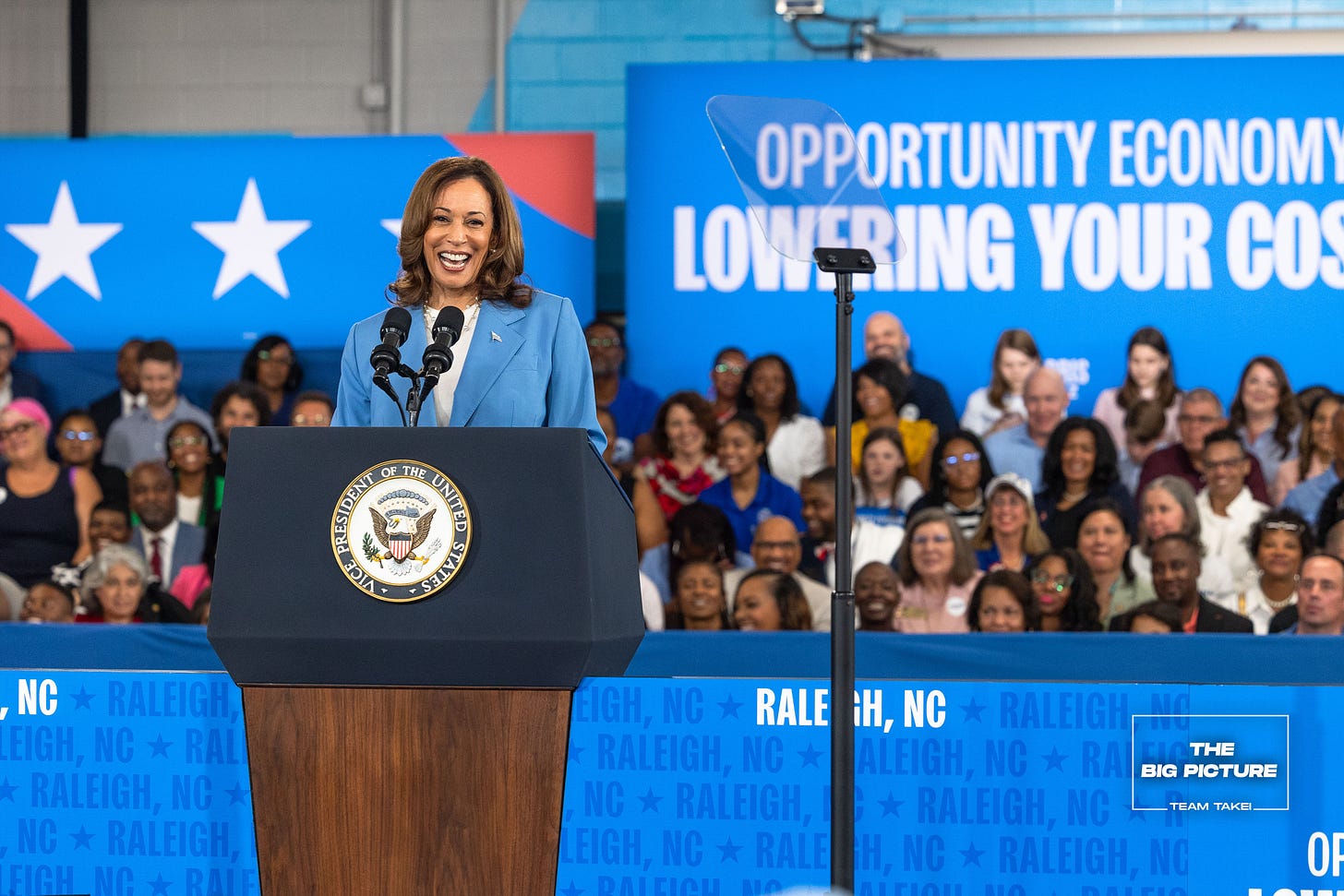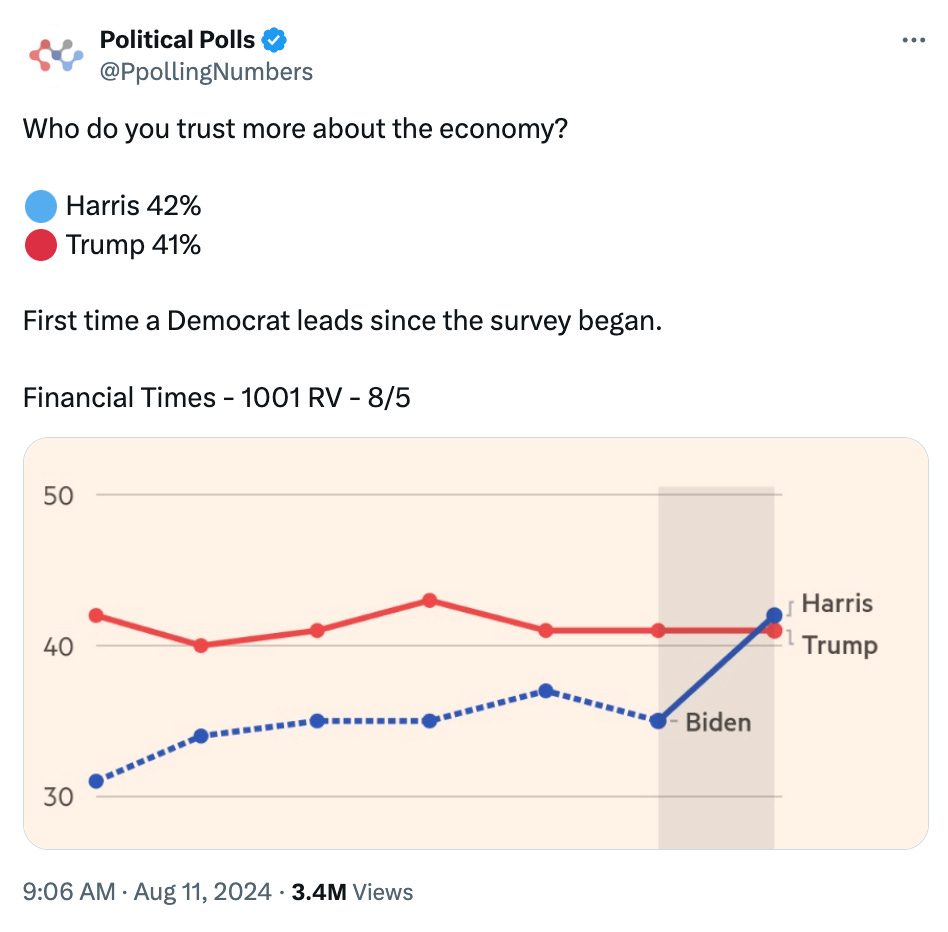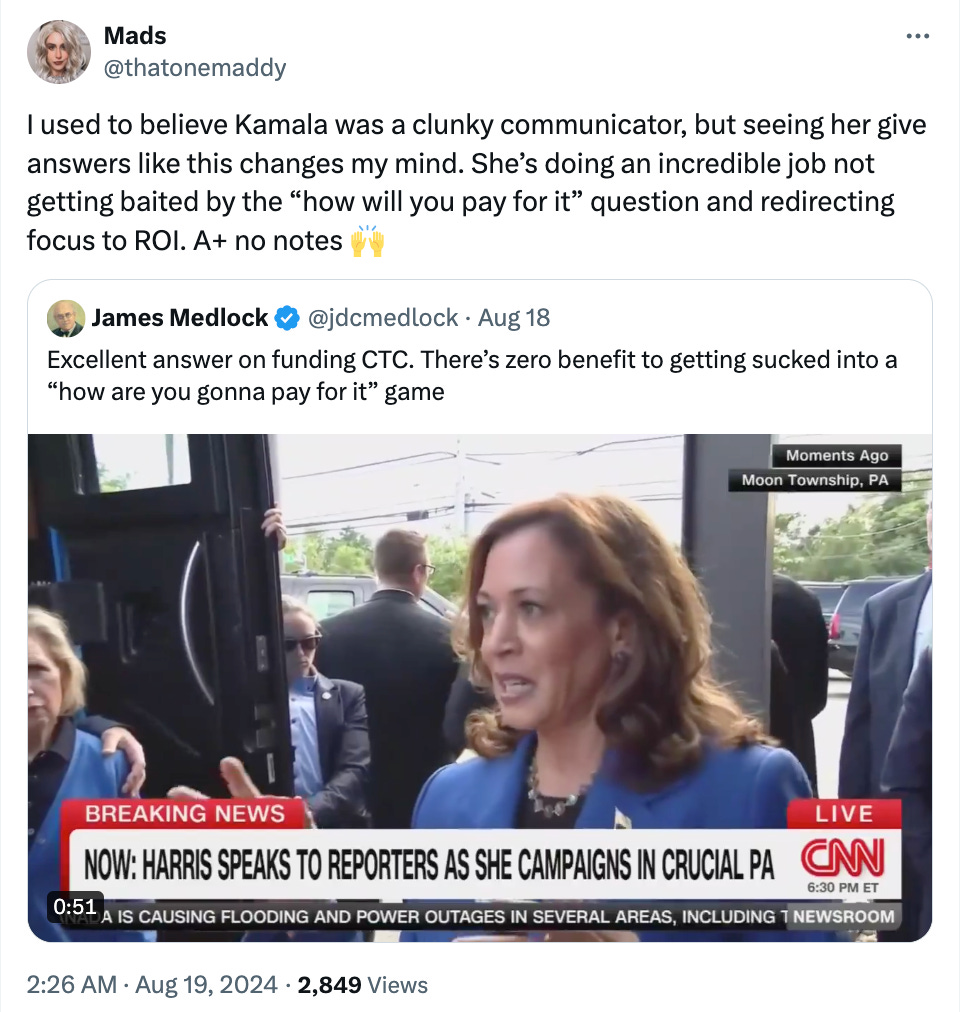Harris Walks a Strategic Line on Policy
The Democratic presidential candidate, mindful of the pitfalls of specifics, has kept ahead of her critics on policy

It’s been somewhat comical over the past couple of weeks to see members of the media and some pearl-clutching pundits cry “Policy!” as though Kamala Harris has somehow been hiding her policy positions from the American people.
It is, of course, fair to ask presidential candidates to lay out where they stand on the issues. And perhaps in the case of Kamala Harris, who is the sitting Vice President and who is running an extremely abbreviated campaign, people are all the more curious where she stands in relation to the President she has faithfully served for three and a half years.
But if there’s one thing the past year should have taught us, as we’ve witnessed Donald Trump’s persistently high level of support despite holding either unintelligible or odious policy positions, it’s that in today’s politics, policy is overrated.
Prior to Joe Biden’s decision to step aside, the polling consensus was that Donald Trump was either even money or a favorite to retake the White House and Republicans would likely hold the House and take back the U.S. Senate. This was true despite their holding minority positions among the electorate on most policies, from abortion rights to climate change to taxing the wealthy.
Indeed by any measure, Joe Biden’s fiscal policies have led to the best post-Covid recovery of any developed nation, yet people still trusted Trump on the economy over Biden.
That’s why it’s been so refreshing to see Harris run a campaign that understands implicitly the limitations of policy as a driver of political support. This is particularly good to see in the face of the usual tendency of Democratic consultants and pollsters to craft carefully honed policy positions based on polling to offend the fewest number of people and offer them up in detailed lists.
Harris also understands there may be more downside than upside to locking yourself in on specific policy positions, as Trump found out the hard way after his allies at The Heritage Foundation put Project 2025 online for all to see.
In today’s piece, I’ll explore the question of whether policies actually matter anymore and how Harris is walking the line between being open and transparent without risking political peril.
Harris’s Economic Policy Rollout
One of the drivers of the clamor for policy specifics from Harris has been the question of whether—and how—she intends to break from Joe Biden. Harris has had to walk a very fine line here.
When it comes to policy, Joe Biden is very much an old-school Democrat, the sort to list his policies and accomplishments as an argument for why you should support him. And we all saw how little that moved the needle against Trump this cycle.
So it would follow that Kamala Harris would do things differently. Take her approach to her rallies, for example, per CNN:
Three weeks into her presidential run was the first time the Biden campaign’s pollsters — now hers — held a deep-dive call with Kamala Harris’ inner circle to discuss what she’s been saying on the stump.
Over the line came a lot of praise, but also some suggested tweaks. First, said veteran Democratic numbers man Geoff Garin, summarizing their analysis, stop saying, “We’re not going back.” It wasn’t focused enough on the future, he argued. Second, lay off all the “weird” talk — too negative.
Harris’ advisers listened. They considered the arguments. They decided to stick with what the crowds were chanting in the arenas.
According to CNN, Harris told her advisors that
she wasn’t going to listen to the pollsters herself and would instead trust [her] instincts…
And that’s exactly what she and her team did when rolling out her first set of economic policies during a speech in North Carolina last week.
Harris’s policy proposals include restoring the expanded child tax credit, a federal ban on price gouging, lowering prescription drug prices for all Americans, and a plan to build three million new affordable homes with the goal of bringing down prices and expanding opportunity for the middle class.
And just look at how it’s being covered.
As CNN put it:
Vice President Kamala Harris on Friday unveiled a populist economic agenda, proposing a new plan to cut taxes for more than 100 million middle-class and lower-income Americans as she builds out the details of her governing agenda weeks after locking down the Democratic presidential nomination.
And The Washington Post:
Vice President Kamala Harris on Friday unveiled an aggressively populist economic agenda to an enthusiastic but intimate crowd, providing the most detailed vision yet of her governing priorities since becoming the Democratic Party’s presidential nominee.
Not only did Harris choose to lean into the issue seen as the biggest driver of discontent among voters, e.g. the economy and high prices, but she also leaned into popular and populist policies that don’t diverge from President Biden as much as they build on what his administration has already done.
Again from WaPo:
“Together we will build what I call an opportunity economy,” Harris said. “Everyone, regardless of who they are or where they start, has an opportunity to build wealth for themselves and their children.”
Some of the economic policies, which Harris’s campaign had announced earlier on Friday, went beyond what President Joe Biden had promised. While Harris is building on much of Biden’s economic agenda, she is also seeking to roll out policies that are unique to her as she works to define herself to millions of voters who may not have a firm grasp of where she stands on a number of key issues.
But the reality is, Kamala Harris was already making gains among voters on the economy even prior to this rollout.
Look at this Financial Times poll from earlier this month, well before last week’s event, which finds Harris overtaking Trump on the issue of who is most trusted on the economy.
For Harris, this economic rollout was not a defensive move to assuage nervous economists. It was an offensive one, where she perceived a weakness in Trump and pounced on it.
The Perils Of Putting Policy To Paper
One of the complaints about Harris during her 2019 presidential primary run was that she was too cautious. I recall seeing clips where she would be asked a tough policy question, and rather than either committing to a stance or pivoting, she would simply say “we need to have that conversation.”
In then-candidate Harris, comments like that projected a lack of conviction and a wishy-washiness that contributed to a sense that she was a candidate who didn’t know who she was or what she stood for.
Harris is clearly determined not to repeat that mistake.
But politics is riddled with stories of candidates on whom overly specific policy positions have backfired.
Look what happened when Project 2025 put their right-wing presidential transition policy blueprint online and touted Trump’s connections to it. It ended up becoming such a liability, as more and more people simply Googled it, that Trump had to distance himself from it and the Heritage Foundation even delayed the publication of a book based on the plan until after the election.
But Harris has learned how to navigate those waters.
After her policy rollout on Friday, Harris took questions from reporters about her economic policies. When asked how she was going to pay for her proposals, Harris simply reframed the question on terms that were favorable to her, saying it was about the “return on investment.”
You can watch the exchange here.
And the reaction speaks for itself.
It’s About The Narrative, Stupid
This is not to say, of course, that taking clear positions on policy should be avoided at all costs. Policy differences are among the best ways candidates can distinguish themselves from their opponents, and certainly in 2024, there is no better issue for Kamala Harris to contrast herself with Trump than on abortion rights.
After Trump’s packed Supreme Court overturned Roe v. Wade two years ago, Kamala Harris found her footing as the Biden administration’s messenger on this crucial issue, which has proven to be a potent vote motivator for Democrats ever since. By contrast, Trump has struggled with how to balance his own “sending it back to the states” abortion message with his base’s desire for a national ban. Whereas Trump is on defense on the issue, Kamala Harris will have no trouble going on offense this fall as multiple states will have initiatives to codify reproductive freedom on their ballots.
But it’s also important that Harris has framed the fight for abortion rights as central to her fight for freedom generally against Trump’s brand of authoritarianism. Harris understands that when it comes to policy, it’s narratives that are ultimately most impactful.
Indeed, when we think back to what the real difference makers were in past elections, it’s rarely specific policy matters.
In 1992, for example, during the “it’s the economy, stupid” election, few could tell you what Clinton’s specific policies were, but many remember George H. W. Bush seeming bewildered by a grocery checkout scanner, which became a symbol of how out of touch he was, a label he ultimately couldn’t shake.
In 2008, as the financial crisis worsened in the final months of the campaign, few could tell you the finer points of the differences between Obama’s and McCain’s strategies for how to solve the crisis. But many remember McCain suspending his campaign to work on a Wall St. bailout plan, which ultimately backfired, making him appear weak.
In fact, Harris had a similarly decisive moment in her race for Attorney General of California in 2010, which The New York Times documents in an article titled The 47 Seconds That Saved Kamala Harris’s Career.
During the one debate in the race, her opponent Steve Cooley was asked whether he would take both a pension he had earned as well as his salary were he to win the race for AG of California. It did not go well for Cooley.
“Do you plan to double-dip by taking both a pension and your salary as attorney general?” Mr. Leonard asked.
“Yes, I do,” Mr. Cooley said without hesitation.
He glanced at Ms. Harris. She said nothing.
“I earned it.”
But Mr. Cooley was not yet done. “I definitely earned whatever pension rights I have, and I will certainly rely upon that to supplement the very low, incredibly low salary that’s paid to the attorney general,” he added.
The Harris campaign proceeded to turn that response into a devastating ad with simple text at the end:
“$150,000 a year isn’t enough?”
That was widely seen as the tipping point in the election, which Harris ended up winning by just 75,000 votes. It was so close, that Cooley took three weeks after Election Day to concede.
Harris knows in her bones the sort of issues that really turn elections. She is running a campaign right now that indicates she has learned all the right lessons, whether it’s from her AG race in 2010, her primary bid in 2019, or the dead heat Biden was in with Trump for months before he dropped out.
And so far, she is using policy masterfully, and selectively, to tell a story that is resonating with the American people.








At Howard Kamala took Economics classes and was president of the Economics Club.
Ok, WHY does it surprise people that Kamala Harris had improved her communication skills and her expertise since 2019? That's what really smart people do. Do we seriously have to explain this? She looked at her weak points, she worked on them, she had all this time being the Vice President - of COURSE she had improved!